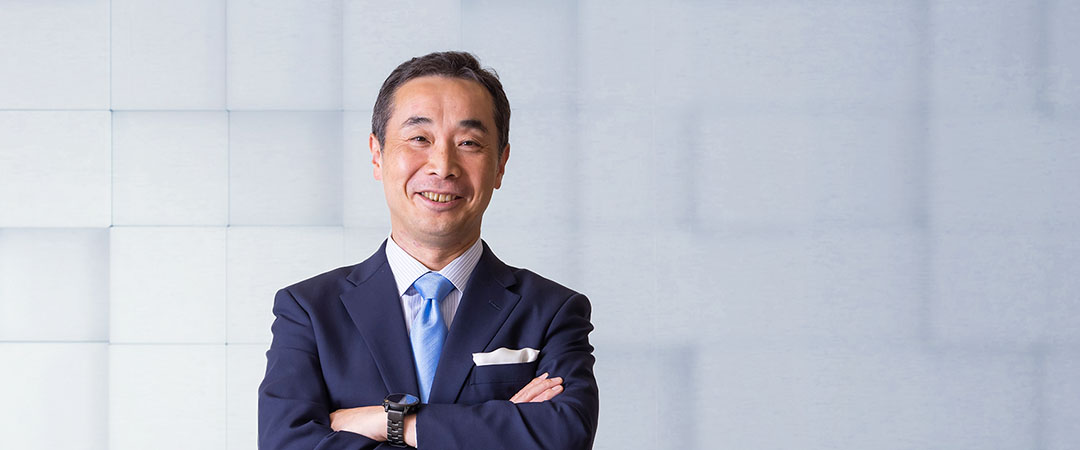
Through strategic resource allocation in accordance
with the business transformation phase,
we aim to realize enhanced corporate value.
Managing Executive Officer,
Chief Financial Officer
To support this transformation, the entire Honda company is united in our effort to “strengthen our business constitution” and we have been implementing measures aimed at improving our profit structure.
In FY2023, due to worsening business conditions, including the impact of cost increases from semiconductor shortages and inflation, as well as higher quality related expenses, company-wide operating profit margin (ROS) was an austere 4.6%. However, in motorcycle business operations, ROS reached 16.8%, an all-time record high. In automobile business operations, the break-even point based on production capacity improved significantly from approximately 90% to roughly 80%, contributing to revenue protection when production is reduced. Through such efforts in each business segment, we are confident that we are making steady progress in improving our profit structure and are aiming to achieve a company-wide ROS target of 7% or more by FY2026. In terms of financial foundation, continuing from FY2022, we generated free cash flow at the level of 700 billion yen. This not only secured funds to support the transformation, but also enabled us to declare an annual dividend of 120 yen. Furthermore, exercising a flexible capital policy, we conducted two share buybacks totaling 170 billion yen during the year.
Given the significant changes in the business environment as well as an increase in the types of risks, including geopolitical risks, it has become crucial to leverage both financial and non-financial capital to attain sustainable growth of cash flows and enhance capital efficiency, thereby boosting corporate value. As a Chief Financial Officer, I believe it is crucial to: 1) clearly define goals for each phase of business transformation and execute strategic resource allocation, 2) ensure reliable execution, strengthen governance and conduct appropriate risk management, including the strengthening of capital cost-conscious management and 3) engage in active dialogue with stakeholders to enhance the quality and transparency of management.
By meticulously executing these missions one by one, we will realize the transformation in what we call the company’s second founding and Honda will continue to be a company that our shareholders want to exist.
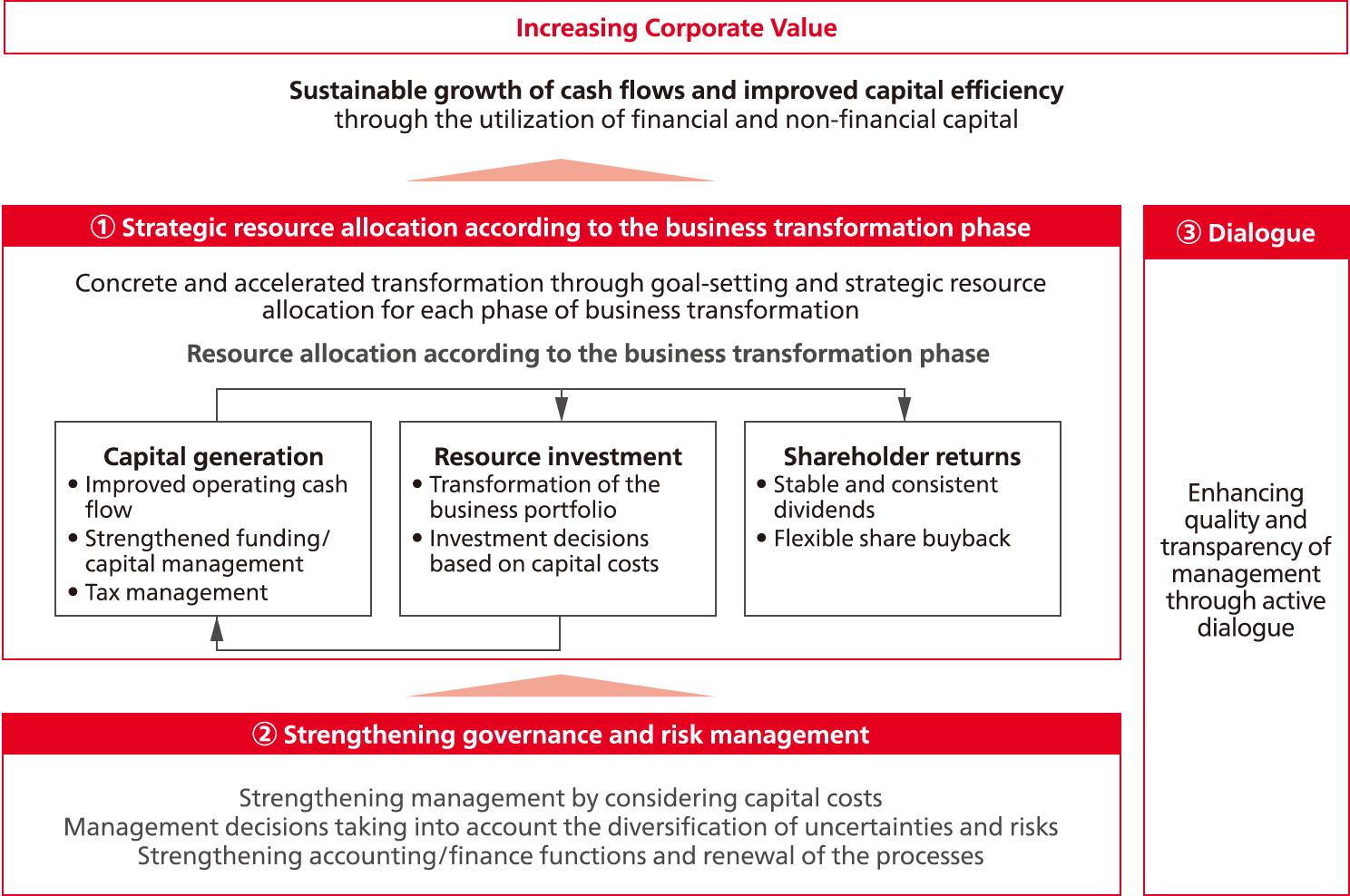
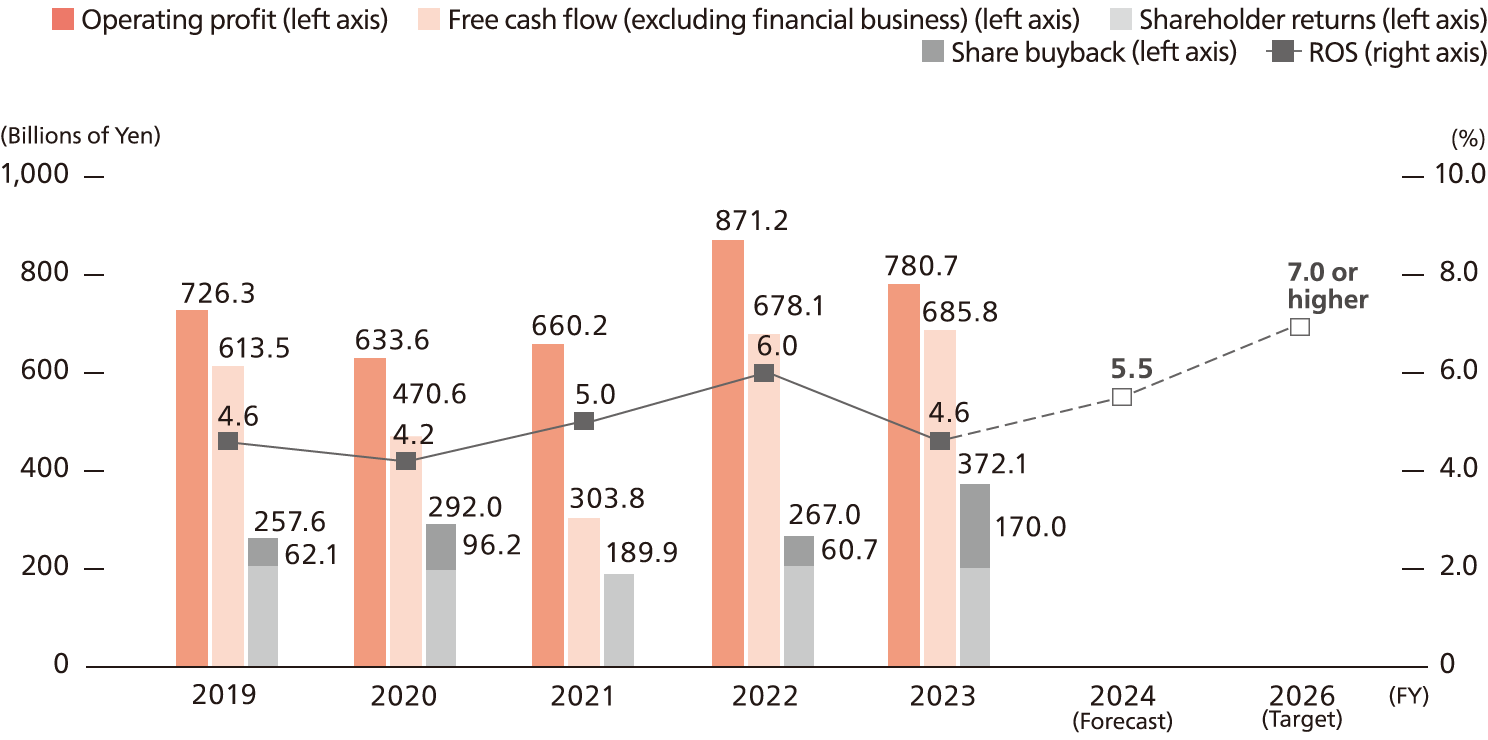
To establish cash generation capabilities through new value creation, we will categorize our management plan into phases of transformation and set specific quantitative goals to drive our initiatives forward. While the PBR (Price-to-Book Ratio) has fallen below 1x, it is crucial to establish a capital return that exceeds the capital cost (ROIC) at an early stage. Additionally, as we aim for “a continual value provision that aligns with the mobility needs of each individual customer’s life,” we believe that leveraging both financial and nonfinancial resources, and ensuring sustained growth of cash flows over the long term, are crucial.
Moving towards 2025, we will sequentially introduce EVs tailored to each region. However, in the phase up to 2025, ICE vehicles will continue to be the core of our sales. From a financial standpoint, as we allocate resources to EVs in order to transform our business portfolio, we will concurrently concentrate on enhancing the business structure of ICE vehicles, with the objective of achieving a company-wide Return on Sales (ROS) of 7% or higher. Strengthening the profitability of our automobile operations is particularly challenging, but we will build upon the business structure we’ve developed through initiatives like the introduction of Honda Architecture~{*2}, consolidated planning, reducing the number of derivatives of our global models and optimizing production capacity. We will also work on strengthening our supply chain, including securing a stable supply of semiconductors, to recover our automobile sales volume and steadily enhance profitability. Having built a robust financial foundation through the enhancement of a solid business structure with these initiatives, we will steadily allocate resources to EVs. Furthermore, by achieving a company-wide ROS of 7% or higher, we will realize an ROIC that exceeds capital costs.
- ICE: Internal Combustion Engine
- Honda Architecture: System architecture connecting computers, sensors, actuators and other components in automobiles
In the period leading up to 2030, we will intensify the allocation of resources to expedite the growth of EV business and attain self-sufficiency in the EV business. By 2030, our objective is to establish a global production capacity exceeding 2 million EVs, while striving for an EV/FCV sales ratio of 40% in developed countries. We will expedite strategic investments that foster the growth of EV business, including the advancement of next-generation batteries like semi-solid-state batteries and all-solid-state batteries. We will also bolster the EV production system through the transformation of our global production system and develop Honda’s distinctive vehicle operating system (OS), which facilitates the post-sale evolution of vehicle features and services post-vehicle sales. Furthermore, we will broaden our range of EV offerings, primarily in both motorcycles and automobiles, while elevating market competitiveness. While there might be an impact from temporary upfront investments, our goal is to bolster the cash generation capability of our ICE (Internal Combustion Engine) business, allocate resources to support transformation, sustain a return on invested capital (ROIC) surpassing the cost of capital and aim for an ROS (Return on Sales) exceeding 5% for the EV segment, along with a company-wide ROIC surpassing 10% by 2030.
We will establish the company’s second founding by expanding the growth of EV business and creating new value. We set the ROS target for the EV business at 10% or higher and strive to achieve a sales ratio of 100% for EV / FCV by 2040, ensuring the sustainable growth of cash flow. To realize the creation of new value, we will stably allocate an annual research budget of around 100 billion yen to fundamental research areas, focusing on carbon-neutral technologies such as the application of intelligence technologies, advancement of battery-related technologies, utilization of hydrogen, and sustainable materials.
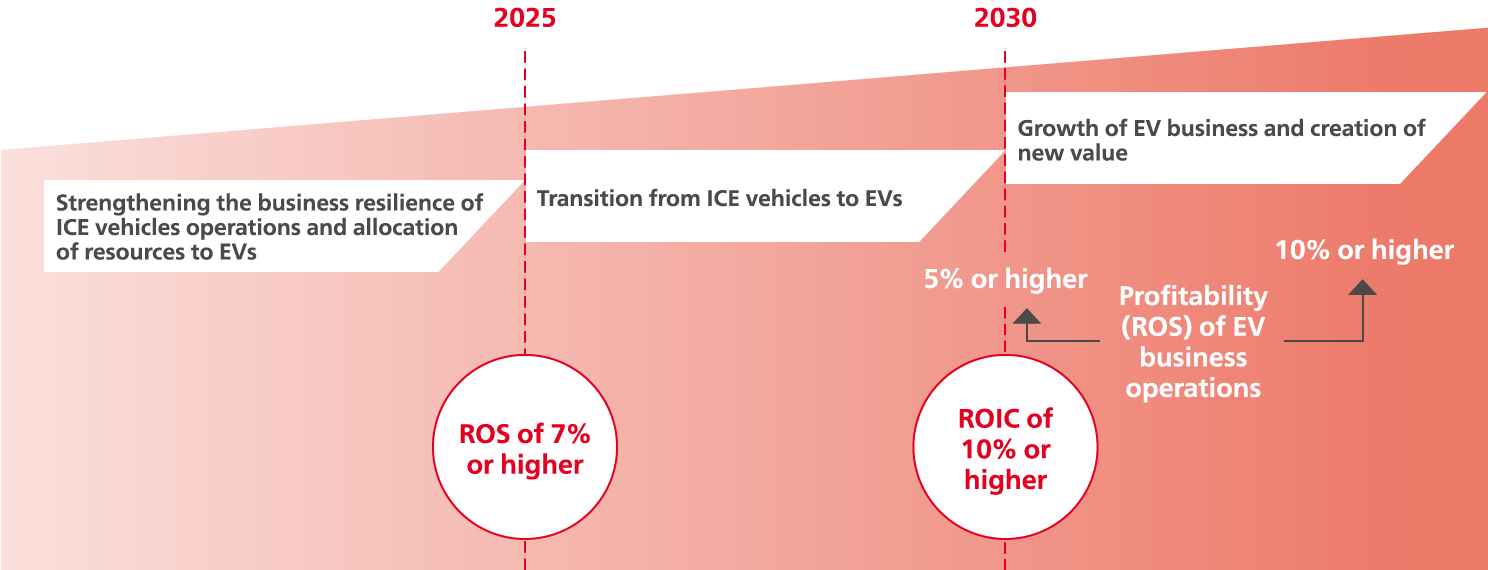

Concerning the distribution of our results, we regard returning profits to our shareholders as one of the foremost management priorities. This determination is made by factoring in internal reserves intended for future growth and the overall performance of the consolidated business, all of which are assessed from a long-term standpoint. Regarding dividends, using a consolidated payout ratio of 30% as a reference, we are committed to achieving steady and consistent dividend payments, capitalizing on Honda’s inherent strengths in generating cash while accelerating resource allocation for transformation. For FY2024, we intend to raise the dividend to an unprecedented level of 150 yen~{*3}. Furthermore, on May 11, 2023, our board of directors approved a share buyback program amounting to 200 billion yen. In line with our goal of enhancing capital efficiency and implementing flexible capital policy, we will judiciously proceed with the repurchase of our own shares.
- On August 9, 2023, during a board of directors meeting, a resolution was passed to execute a stock split at a ratio of 3 shares for every 1 share, with September 30, 2023, as the designated record date. Following this stock split, adjustments were made to the dividend forecast. However, the annual dividend forecast of 150 yen, as announced on May 11, 2023, remains unchanged based on the pre-stock split standard.
In an era of significant transformation, our objective is to enhance governance and infuse management practices with a heightened awareness of capital costs. This approach will empower us to respond flexibly and effectively to evolving environmental dynamics, ultimately elevating our corporate value. We will employ the ROIC framework to seamlessly connect on-ground initiatives with company-wide objectives. Our efforts will focus on optimizing profits, the numerator in ROIC~{*4}, while enhancing the denominator—deployed capital~{*5}—through prudent utilization of retained assets and strategic investment discernment, thus enhancing capital efficiency. Concerning our financial services business, where funding predominantly relies on liabilities, we will apply the ROE metric to strike a balance between profitability and stability. This balanced approach will maximize capital efficiency and lend support to our transformative endeavors.
When it comes to resource allocation, given the substantial uncertainties stemming from economic trends, shifts in environmental regulations and technological breakthroughs, the necessity of substantial investments for transformation becomes evident. As a risk management strategy, we are committed to identifying decision triggers and making investment choices while considering capital costs.
We firmly believe that increasing corporate value goes beyond merely outlining a roadmap for sustainable cash flow growth and improved capital efficiency. It also entails ensuring that Honda’s prospects are well comprehended in the capital markets.
To achieve this, a fundamental requirement is that our stakeholders, including shareholders and investors, have an accurate understanding and a positive regard for our management direction. Taking proactive measures, our management team will engage in more active dialogues than ever before, conducted through various events and individual meetings. Through these dialogues, our management team will gain direct insights into the expectations and interests of the capital markets. We consider this feedback from stakeholders as highly valuable and will integrate it into our anagement approach, thus contributing to a further augmentation of corporate value.
For specific information regarding our dialogue achievements in FY2023 and the ensuing feedback within the company, we invite you to visit our Communication with Investors and Securities Analysts page in our official website (https://global.honda/en/investors/policy/communication.html).
We appreciate your ongoing support and look forward to your anticipation of the continuous enhancement of Honda’s corporate value.
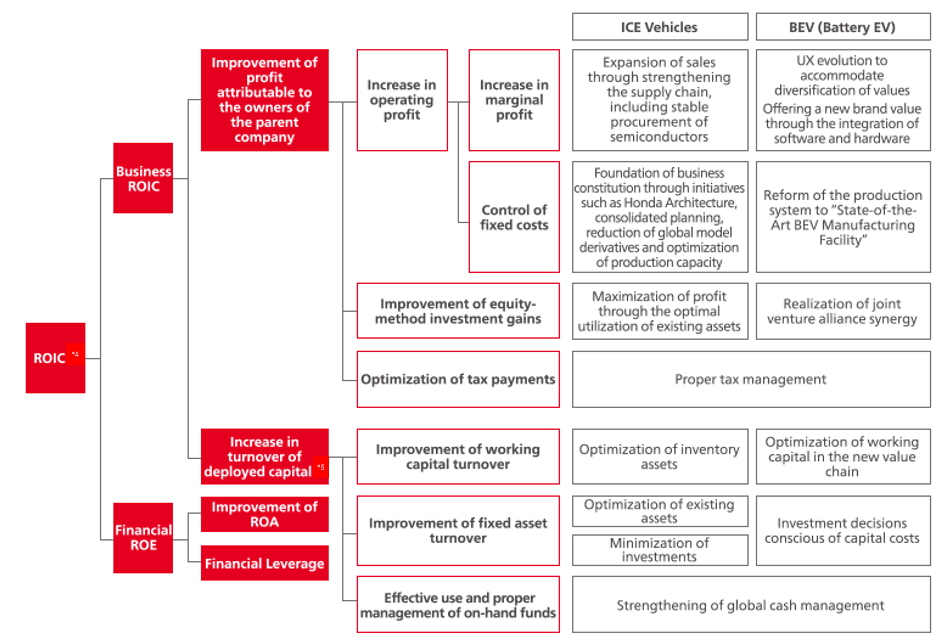
- ROIC: Net income attributable to the parent company owners + Interest expenses (excluding financial businesses) / Deployed Capital
- Deployed capital: Shareholders’ equity attributable to the company’s shareholders + Interest-bearing liabilities (excluding those from the financial business sector). Deployed capital is calculated using the average of the beginning and end of the period.